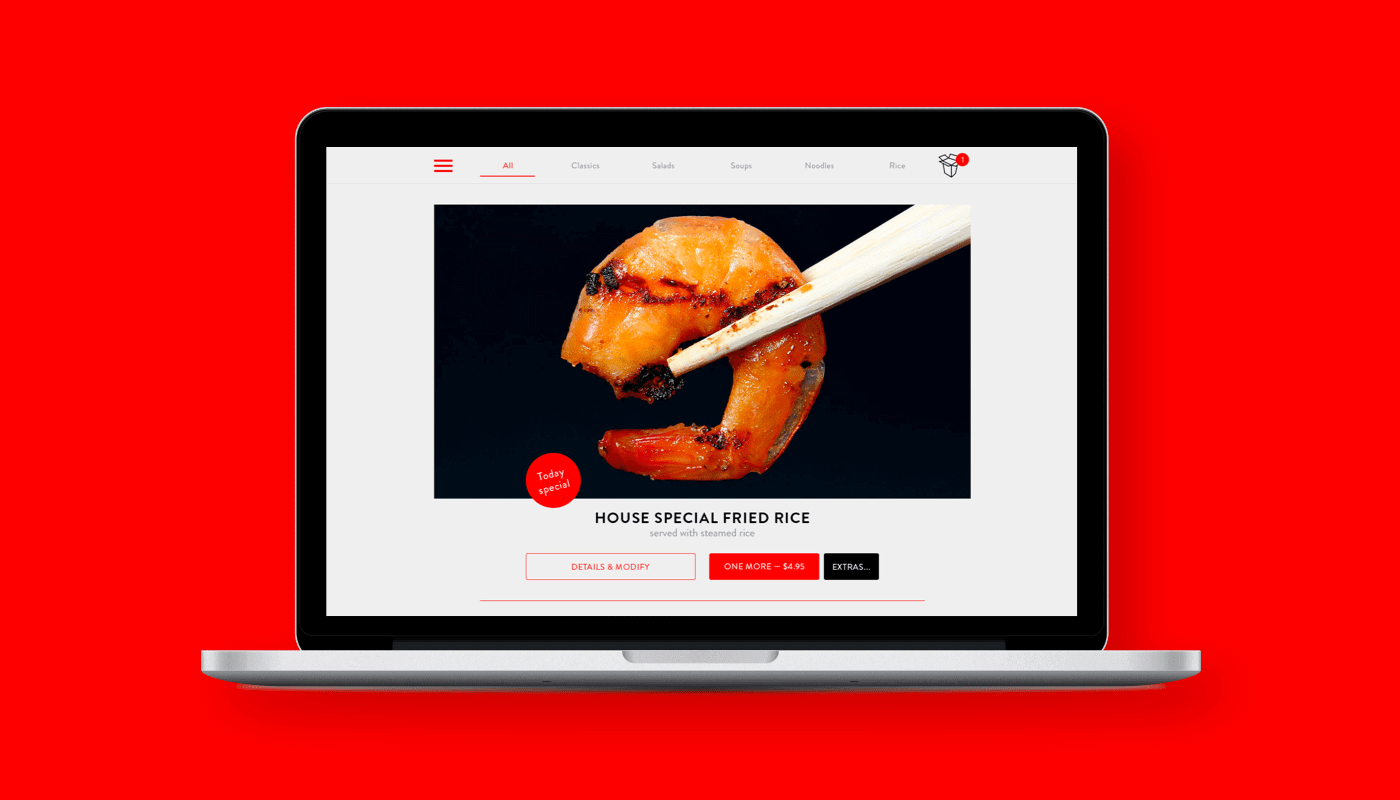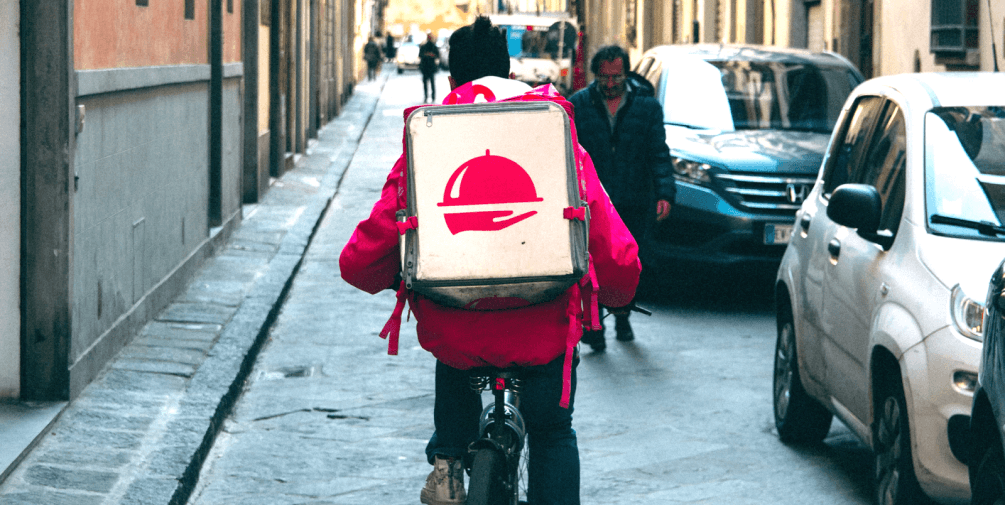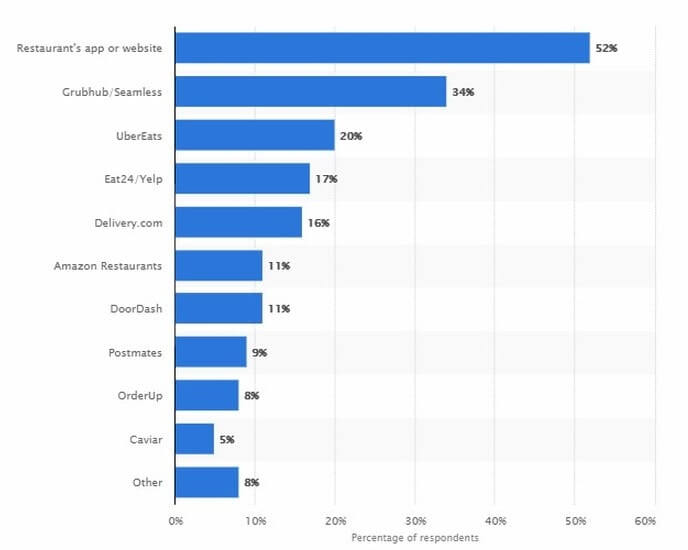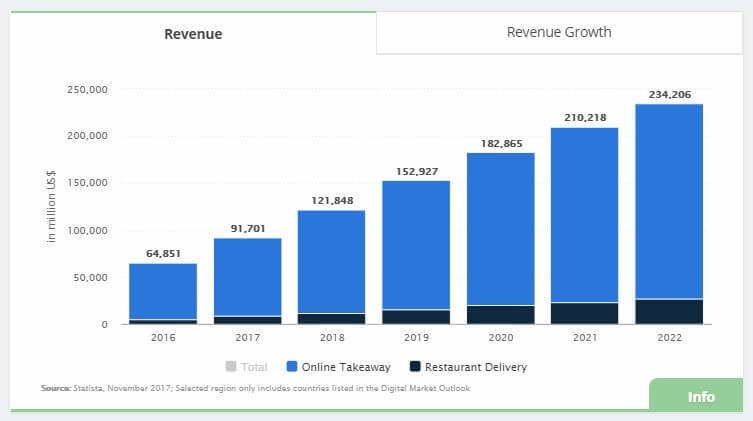Most likely, you already know that the online food delivery market is growing rapidly. It’s confirmed by the figures of recent research—43% of all delivery orders is online delivery. You must admit that it would be cool to get this piece of the market yourself.
We are S-PRO. Our company is an expert in food tech platforms development. We know that building a food delivery app is not an easy task. In this article, you’ll get to know all the development stages, structure the information, and be guided in the right direction.
Numbers
The transition of food tech business from offline to online is a worldwide trend. According to Statista, the most used restaurant delivery services in the US in 2017 were GrubHub/Seamless, UberEats, Eat24/Yelp, Delivery.com, Amazon Restaurants, DoorDash, Postmates, OrderUp, and Caviar.
Screenshot from Statista portal
Benefits from such apps-aggregators are obvious—both for consumers of food and for its suppliers. As the forecast shows, revenue of food tech market will only grow each year:
Screenshot from Statista portal
The Key Issues of a Foodtech Platform Development
To become a market leader a business owner must take into account five issues.
1. Target Market
The choice of a target market depends on users’ goals and needs. A food delivery app can focus on ready meals delivery (soups, salads, steaks), grocery delivery (dairy products, cereals, oil), serving specific curated menus based on customers’ diets including recipes and ingredients (vegetarian, proper nutrition, Chinese cuisine), or products directly from farmers and fishermen.
A food tech platform can serve such types of users in a specific region (regions) or across a country (countries) as:
- men/women who don’t have time for cooking
- couples with/without children who order foods for the weekend
- corporate dinners
- student parties
- holidays/events
As you see, there is a great choice to find the right target market for an app.
2. Competitors Analysis
The boost of online deliveries causes tough competition among startups. Some platforms fail to compete and shut down. If you don’t want to be among the losers and want to increase the chances of success—competitors analysis before launching an app is a must.
The research should contain as much information as possible about competitive platforms:
- location
- services
- customers
- success stories and failures
- profit and loss
Based on these data you need to provide unique food tech solutions and offers to meet users’ goals and needs. As a result, you can count on market leadership.
3. Smooth Cooperation
Smooth and trusted cooperation between a startup and restaurants, food vendors, or local farming will ensure the success of a food tech platform. The choice of future partners depends on the specific business model.
For example, London-based Farmdrop, an online grocer, works with local farmers and fishermen. The company starts collecting organic foods from the fields only after receiving orders. As a result, they managed to create a zero-waste kitchen.
GrubHub, in its turn, as an intermediary company, works in partnership with restaurants. Restaurants pay commission fees for orders, customers—for deliveries. As a result, partners receive more orders and are given wide publicity, while a delivery app has a constant increase in users flow.
These two companies have a different approach, but they are united by smooth cooperation and strong relationship with partners.
4. Drivers Network
Orders must be delivered in the fastest way possible and they need to be piping hot. So drivers network should be well-thought-out.
To arrange fast food delivery a business owner should think of:
- part-time or full-time drivers
- hire employees or rely on freelancers
- choose a required type of transport—bicycle, scooter, car, small truck
- partnership with third-party delivery service
- climate zone, transport development, and roads conditions in the region are no less important
- fast delivery
5. Tech Features and Solutions
A good food tech platform requires the implementation of functions which meet the needs of customers, restaurant staff, and drivers. Thus, three groups of tech features should be developed to satisfy all parties:
- Customers should have a streamlined website, convenient list of restaurants, simple menu layout, and easy online food ordering.
- The restaurant team should have ordered a management platform, CRM and CMS systems, minimal human interference, and maximal process automation.
- Drivers should have access to the list of orders and necessary external services.
UI/UX Design
Human-centered design principles in design creation for the project are no less important. They allow you to receive a modern, familiar, and user-friendly interface for all mentioned groups of users.
How It Looks in Practice

Let's see how it all looks in practice on the example of Austin-based Tso Chinese Delivery. This is a food tech startup founded by our customers. We’ve been working with them since September 2016. It's an ongoing project that was launched in August 2017. Our team continues to support the platform, improve, implement new solutions, adjust the system, and provide maximum flexibility to cope with the constant increase of user flow. By the way, you can read more about the project on our website—follow this link.
This web app with real-time features was developed as a base for a multitenant platform. The challenge was to build a tool which would automate business and delivery processes of a Chinese restaurant with a convenient cashless payment system.
First, the MVP version was developed. Then the project was submitted for beta testing to startup partners. At the same time, the audience, competitors, markets were analyzed. After that, there was a release of the system. In the process, work on business needs continued. It became clear what needs were necessary to be added, to be changed, and to be removed.
Tech Stack
To make business processes as flexible as possible we used JavaScript both on frontend and backend. The backend is also built with Node.js. It allowed reusing the code and solutions between the server and the client. It helped to reduce the amount of code and, as a result, to reduce the number of errors. We made the platform more supportable—it's easy to make changes and fix bugs.
It’s an isomorphic (universal) app. When users visit the page, currently needed data, resources and code are uploaded. It allowed to significantly speed up the initial pages loading, as well as the app performance as a whole.
We built frontend with React, which is one of the fastest frameworks. It allowed achieving fast page rendering and excellent dynamics for the best UX. SocketIO was chosen to provide real-time messaging. It allowed users to receive notifications and relevant information as quickly as possible.
We tested the app with manual functional and UI testing (on real devices and with BrowserStack), auto testing (with Selenium Webdriver and Java), API testing (with Postman). This allowed reducing the time for testing new releases and gave confidence that previously written features weren't broken.
To make an admin system work, a powerful server is needed. We used Amazon Web Services (AWS) to provide the largest possible uptime for our app.
Delivery platforms can’t function fully without geolocation. We integrated the app with third-party services such as Google APIs and Google Maps. Bringing service was integrated for drivers and orders tracking for users.
Payment system must be convenient and secure, so several services have been integrated for ease of use.
Features
Take a look at the features we’ve provided for Tso Chinese Delivery. You can use them as a basic example to implement your own unique solutions.



Conclusions
From the article, you learned the stages and ideas for building a food delivery app. To develop a food tech platform, depending on the complexity and functionality, it will take about 1000 hours.
The cost of the development team depends on its region. We wrote in detail about the rates in the blog—follow this link for more information.
Each businessman has a certain budget and desires. Most skilled entrepreneurs who want to save money and don’t forget about quality choose experts from Eastern Europe. This region is the golden mean of quality-price ratio.
In order not to waste time, feel free to contact us. We can give advice on each stage of startup creation, from the analysis of the idea to the technical implementation, and estimate your project if it’s developed by our team.







